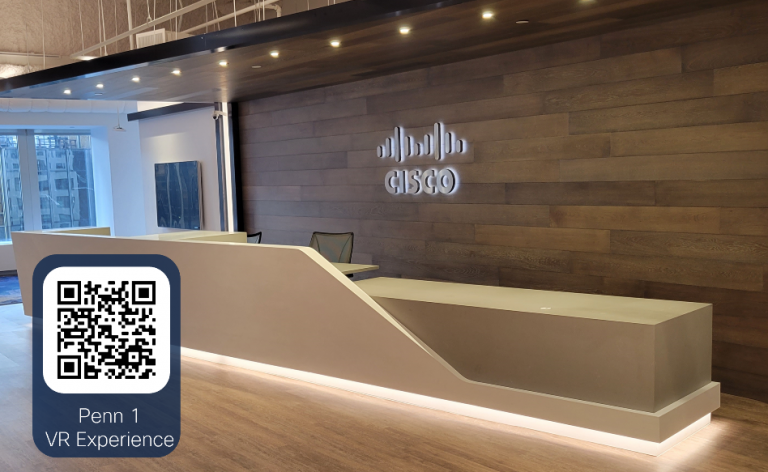The first time I put on VR goggles was at Cisco Live in Vegas. Instead of going to Everest or the Great Barrier Reef, I did a virtual tour of the complete Smart Building retrofit of Penn1 Plaza in New York City. I remember visiting the building so many times before the remodel, so to ‘see it’ and all the amazing technology and innovations that made the building smart and sustainable. See it for yourself (scan the QR code)!

Less than a week later, I found myself walking through Penn1’s airy lobby in real life with a touchless QR code and elevator up to Cisco’s floor. Although the building was built in 1972, it went through a major retrofit to make it more energy efficient, and hybrid work friendly. Penn1 is one of countless Smart Building retrofits that will cumulatively generate a total of $959 billion from 2014 through 2023, according to Advanced Energy Now 2021 Market Report , as part of trillions invested in the overall building efficiency market.
The Penn1 Smart Building story
There has been a lot of great coverage about this first of many Cisco Smart Buildings fully powered by Power over Ethernet (PoE), but there is one element that really struck me. In this “age of action”, the data from this converged infrastructure allows us to collect actionable data from user devices, sensors, systems, and services on the premises as insights for better operations.
The design principle for Penn1 was technology-first, architecture-second with technology serving as the “fourth utility” after water, gas, and power. Penn1 consolidates multiple building control systems such as HVAC, lighting, alarms, and security over a single, intelligent network infrastructure that converges data and power through next-generation PoE technology that operates over DC power. According to CSA Group there is over a 45% reduction in energy waste by using DC power, saving energy and reducing operating costs.
Penn1 features 100% PoE architecture for the building retrofit, fully converging IT/OT/IoT. From automated blinds, smart-powered desks and lighting, there are over 5,000 endpoints providing data to the network. I was really impressed with the smart functionality with embedded sensors throughout the building. With these sensors, you can keep power going more deliberately to the right places, at the right time.

In other words, Penn1 does not operate on an “always on” mode. Instead, it can intelligently toggle from three different operating modes to ensure that the building is operating as efficiently as possible.
- Occupied: Enabling common and highly trafficked areas to be operational to ensure a pleasant occupant experience including many automated functions, e.g., how I saw the blinds lift based on the number of people in a room and the amount of ambient light available.
- Unoccupied standby/hibernate: Like a laptop that cycles down when not in use, Penn1 rooms have a hibernate mode. For example, a quiet, unoccupied room I entered sensed my presence and lit up ready for action. Also, the Webex Desk Pro in the room connected with my laptop allowing me to join a meeting with just a few clicks.
- Scheduled ‘Off’: During non-business hours and on the weekends, Penn1 goes into energy-conservation mode and shuts off almost everything but the most vital functions.
There’s a lot of powerful infrastructure that makes this possible, including Cisco’s software-defined access solutions that enhance the infrastructure with visibility, segmentation, policy enforcement, and continuous trust assessment. This paves the way to use artificial intelligence and machine learning (AI/ML) technologies to implement building-wide automation and programmability. In time, I can see a future where we move beyond various settings and modes to even smarter dynamic systems that are always learning, adjusting, and evolving.
Learn more about Cisco Smart Building solutions
Like a model home, we built Penn1 to showcase the possibilities of Smart Buildings and the many intelligent, intuitive, and transformative technologies that power them. Many of these are Cisco technologies, including 90W universal PoE, Meraki MV smart cameras, and DNA Spaces management platform.
Working together, these technologies add tremendous value to any facility by enabling sustainable operations, increasing security, and enhancing the overall user experience. Over the past four months, over 200 customers have toured Penn1, spending two and a half hours on average. While it’s not quite the same as a site visit, please check out this great video that features many aspects of the Penn1 Smart Building technologies in action. Better yet, schedule a tour of Penn1 and experience it for yourself!
Building owners and companies ready to take the next step can start by reading Cisco’s Smart Building Guide or visiting our Smart Building solutions page at: https://www.cisco.com/c/en/us/solutions/smart-building.html#~benefits.
CONNECT WITH US